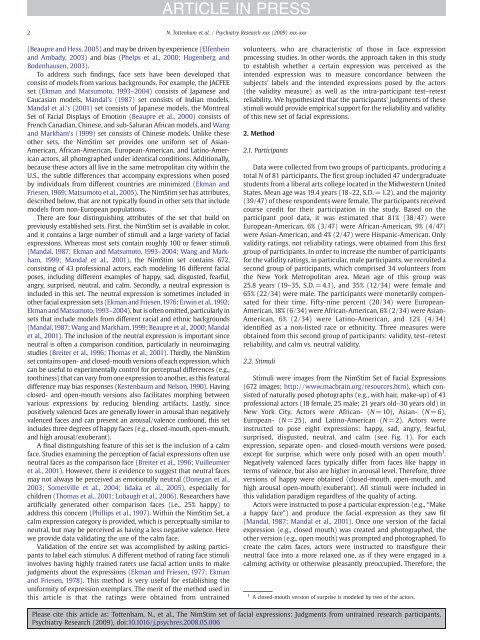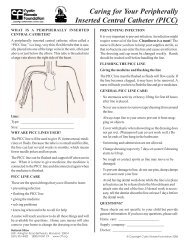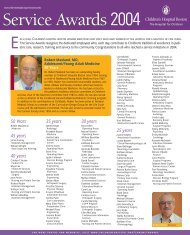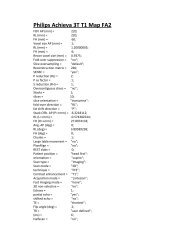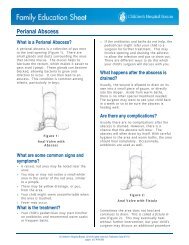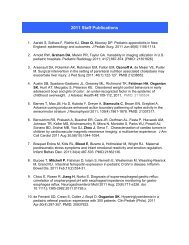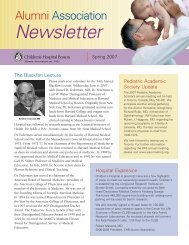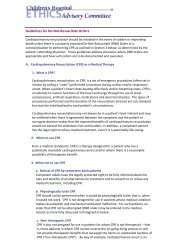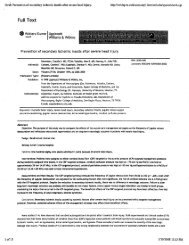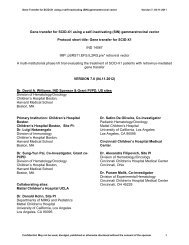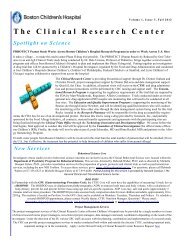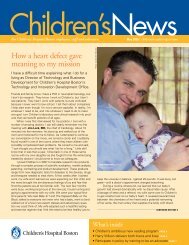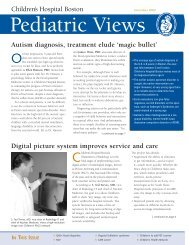The NimStim set of facial expressions - Children's Hospital Boston
The NimStim set of facial expressions - Children's Hospital Boston
The NimStim set of facial expressions - Children's Hospital Boston
Create successful ePaper yourself
Turn your PDF publications into a flip-book with our unique Google optimized e-Paper software.
(Beaupre and Hess, 2005) and may be driven by experience (Elfenbein<br />
and Ambady, 2003) and bias (Phelps et al., 2000; Hugenberg and<br />
Bodenhausen, 2003).<br />
To address such findings, face <strong>set</strong>s have been developed that<br />
consist <strong>of</strong> models from various backgrounds. For example, the JACFEE<br />
<strong>set</strong> (Ekman and Matsumoto, 1993–2004) consists <strong>of</strong> Japanese and<br />
Caucasian models, Mandal's (1987) <strong>set</strong> consists <strong>of</strong> Indian models,<br />
Mandal et al.'s (2001) <strong>set</strong> consists <strong>of</strong> Japanese models, the Montreal<br />
Set <strong>of</strong> Facial Displays <strong>of</strong> Emotion (Beaupre et al., 2000) consists <strong>of</strong><br />
French Canadian, Chinese, and sub-Saharan African models, and Wang<br />
and Markham's (1999) <strong>set</strong> consists <strong>of</strong> Chinese models. Unlike these<br />
other <strong>set</strong>s, the <strong>NimStim</strong> <strong>set</strong> provides one uniform <strong>set</strong> <strong>of</strong> Asian-<br />
American, African-American, European-American, and Latino-American<br />
actors, all photographed under identical conditions. Additionally,<br />
because these actors all live in the same metropolitan city within the<br />
U.S., the subtle differences that accompany <strong>expressions</strong> when posed<br />
by individuals from different countries are minimized (Ekman and<br />
Friesen, 1969; Matsumoto et al., 2005). <strong>The</strong> <strong>NimStim</strong> <strong>set</strong> has attributes,<br />
described below, that are not typically found in other <strong>set</strong>s that include<br />
models from non-European populations.<br />
<strong>The</strong>re are four distinguishing attributes <strong>of</strong> the <strong>set</strong> that build on<br />
previously established <strong>set</strong>s. First, the <strong>NimStim</strong> <strong>set</strong> is available in color,<br />
and it contains a large number <strong>of</strong> stimuli and a large variety <strong>of</strong> <strong>facial</strong><br />
<strong>expressions</strong>. Whereas most <strong>set</strong>s contain roughly 100 or fewer stimuli<br />
(Mandal, 1987; Ekman and Matsumoto, 1993–2004; Wang and Markham,<br />
1999; Mandal et al., 2001), the <strong>NimStim</strong> <strong>set</strong> contains 672,<br />
consisting <strong>of</strong> 43 pr<strong>of</strong>essional actors, each modeling 16 different <strong>facial</strong><br />
poses, including different examples <strong>of</strong> happy, sad, disgusted, fearful,<br />
angry, surprised, neutral, and calm. Secondly, a neutral expression is<br />
included in this <strong>set</strong>. <strong>The</strong> neutral expression is sometimes included in<br />
other <strong>facial</strong> expression <strong>set</strong>s (Ekman and Friesen,1976; Erwin et al.,1992;<br />
Ekman and Matsumoto,1993–2004), but is <strong>of</strong>ten omitted, particularly in<br />
<strong>set</strong>s that include models from different racial and ethnic backgrounds<br />
(Mandal,1987; Wang and Markham,1999; Beaupre et al., 2000; Mandal<br />
et al., 2001). <strong>The</strong> inclusion <strong>of</strong> the neutral expression is important since<br />
neutral is <strong>of</strong>ten a comparison condition, particularly in neuroimaging<br />
studies (Breiter et al., 1996; Thomas et al., 2001). Thirdly, the <strong>NimStim</strong><br />
<strong>set</strong> contains open- and closed-mouth versions <strong>of</strong> each expression, which<br />
can be useful to experimentally control for perceptual differences (e.g.,<br />
toothiness) that can vary from one expression to another, as this featural<br />
difference may bias responses (Kestenbaum and Nelson, 1990). Having<br />
closed- and open-mouth versions also facilitates morphing between<br />
various <strong>expressions</strong> by reducing blending artifacts. Lastly, since<br />
positively valenced faces are generally lower in arousal than negatively<br />
valenced faces and can present an arousal/valence confound, this <strong>set</strong><br />
includes three degrees <strong>of</strong> happy faces (e.g., closed-mouth, open-mouth,<br />
and high arousal/exuberant).<br />
A final distinguishing feature <strong>of</strong> this <strong>set</strong> is the inclusion <strong>of</strong> a calm<br />
face. Studies examining the perception <strong>of</strong> <strong>facial</strong> <strong>expressions</strong> <strong>of</strong>ten use<br />
neutral faces as the comparison face (Breiter et al., 1996; Vuilleumier<br />
et al., 2001). However, there is evidence to suggest that neutral faces<br />
may not always be perceived as emotionally neutral (Donegan et al.,<br />
2003; Somerville et al., 2004; Iidaka et al., 2005), especially for<br />
children (Thomas et al., 2001; Lobaugh et al., 2006). Researchers have<br />
artificially generated other comparison faces (i.e., 25% happy) to<br />
address this concern (Phillips et al., 1997). Within the <strong>NimStim</strong> Set, a<br />
calm expression category is provided, which is perceptually similar to<br />
neutral, but may be perceived as having a less negative valence. Here<br />
we provide data validating the use <strong>of</strong> the calm face.<br />
Validation <strong>of</strong> the entire <strong>set</strong> was accomplished by asking participants<br />
to label each stimulus. A different method <strong>of</strong> rating face stimuli<br />
involves having highly trained raters use <strong>facial</strong> action units to make<br />
judgments about the <strong>expressions</strong> (Ekman and Friesen, 1977; Ekman<br />
and Friesen, 1978). This method is very useful for establishing the<br />
uniformity <strong>of</strong> expression exemplars. <strong>The</strong> merit <strong>of</strong> the method used in<br />
this article is that the ratings were obtained from untrained<br />
ARTICLE IN PRESS<br />
2 N. Tottenham et al. / Psychiatry Research xxx (2009) xxx-xxx<br />
volunteers, who are characteristic <strong>of</strong> those in face expression<br />
processing studies. In other words, the approach taken in this study<br />
to establish whether a certain expression was perceived as the<br />
intended expression was to measure concordance between the<br />
subjects' labels and the intended <strong>expressions</strong> posed by the actors<br />
(the validity measure) as well as the intra-participant test–retest<br />
reliability. We hypothesized that the participants' judgments <strong>of</strong> these<br />
stimuli would provide empirical support for the reliability and validity<br />
<strong>of</strong> this new <strong>set</strong> <strong>of</strong> <strong>facial</strong> <strong>expressions</strong>.<br />
2. Method<br />
2.1. Participants<br />
Data were collected from two groups <strong>of</strong> participants, producing a<br />
total N <strong>of</strong> 81 participants. <strong>The</strong> first group included 47 undergraduate<br />
students from a liberal arts college located in the Midwestern United<br />
States. Mean age was 19.4 years (18–22, S.D.=1.2), and the majority<br />
(39/47) <strong>of</strong> these respondents were female. <strong>The</strong> participants received<br />
course credit for their participation in the study. Based on the<br />
participant pool data, it was estimated that 81% (38/47) were<br />
European-American, 6% (3/47) were African-American, 9% (4/47)<br />
were Asian-American, and 4% (2/47) were Hispanic-American. Only<br />
validity ratings, not reliability ratings, were obtained from this first<br />
group <strong>of</strong> participants. In order to increase the number <strong>of</strong> participants<br />
for the validity ratings, in particular, male participants, we recruited a<br />
second group <strong>of</strong> participants, which comprised 34 volunteers from<br />
the New York Metropolitan area. Mean age <strong>of</strong> this group was<br />
25.8 years (19–35, S.D. = 4.1), and 35% (12/34) were female and<br />
65% (22/34) were male. <strong>The</strong> participants were monetarily compensated<br />
for their time. Fifty-nine percent (20/34) were European-<br />
American, 18% (6/34) were African-American, 6% (2/34) were Asian-<br />
American, 6% (2/34) were Latino-American, and 12% (4/34)<br />
identified as a non-listed race or ethnicity. Three measures were<br />
obtained from this second group <strong>of</strong> participants: validity, test–retest<br />
reliability, and calm vs. neutral validity.<br />
2.2. Stimuli<br />
Stimuli were images from the <strong>NimStim</strong> Set <strong>of</strong> Facial Expressions<br />
(672 images; http://www.macbrain.org/resources.htm), which consisted<br />
<strong>of</strong> naturally posed photographs (e.g., with hair, make-up) <strong>of</strong> 43<br />
pr<strong>of</strong>essional actors (18 female, 25 male; 21 years old–30 years old) in<br />
New York City. Actors were African- (N =10), Asian- (N =6),<br />
European- (N =25), and Latino-American (N = 2). Actors were<br />
instructed to pose eight <strong>expressions</strong>: happy, sad, angry, fearful,<br />
surprised, disgusted, neutral, and calm (see Fig. 1). For each<br />
expression, separate open- and closed-mouth versions were posed,<br />
except for surprise, which were only posed with an open mouth 1 .<br />
Negatively valenced faces typically differ from faces like happy in<br />
terms <strong>of</strong> valence, but also are higher in arousal level. <strong>The</strong>refore, three<br />
versions <strong>of</strong> happy were obtained (closed-mouth, open-mouth, and<br />
high arousal open-mouth/exuberant). All stimuli were included in<br />
this validation paradigm regardless <strong>of</strong> the quality <strong>of</strong> acting.<br />
Actors were instructed to pose a particular expression (e.g., “Make<br />
a happy face”) and produce the <strong>facial</strong> expression as they saw fit<br />
(Mandal, 1987; Mandal et al., 2001). Once one version <strong>of</strong> the <strong>facial</strong><br />
expression (e.g., closed mouth) was created and photographed, the<br />
other version (e.g., open mouth) was prompted and photographed. To<br />
create the calm faces, actors were instructed to transfigure their<br />
neutral face into a more relaxed one, as if they were engaged in a<br />
calming activity or otherwise pleasantly preoccupied. <strong>The</strong>refore, the<br />
1 A closed-mouth version <strong>of</strong> surprise is modeled by two <strong>of</strong> the actors.<br />
Please cite this article as: Tottenham, N., et al., <strong>The</strong> <strong>NimStim</strong> <strong>set</strong> <strong>of</strong> <strong>facial</strong> <strong>expressions</strong>: Judgments from untrained research participants,<br />
Psychiatry Research (2009), doi:10.1016/j.psychres.2008.05.006


